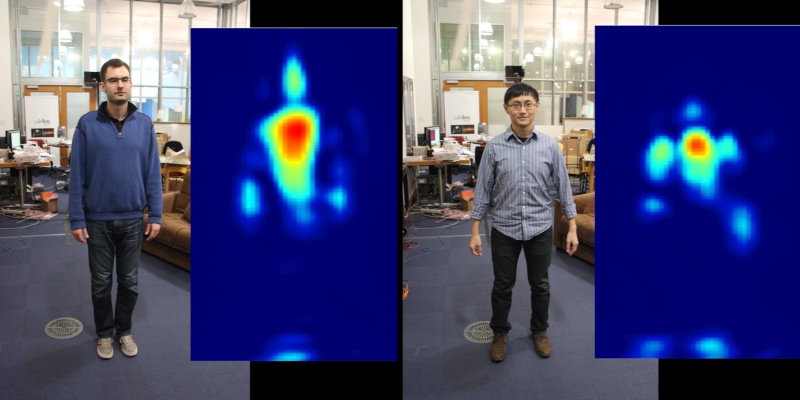Researchers at MIT's Computer Science and Artificial Intelligence Lab are developing a device that can identify people through walls using Wi-Fi signals. The amazing technology, called RF-Capture, "can trace a person's hand as he writes in the air and even distinguish between 15 different people through a wall with nearly 90 percent accuracy," MIT said in an announcement today.
The team at MIT has been working on this technology for the last few years; in 2013, they showed off similar radio frequency technology that could detect the presence of human motion from the other side of a wall, Gizmodo reports. But now, after two more years of developing RF-Capture, the technology is sophisticated enough to 'see' the silhouette of a person standing behind a wall.
RF-Capture works by transmitting wireless signals through a wall which are then reflected off people's bodies on the other side. Those reflections are captured by the device and, using an algorithm to identify body parts, are stitched together to create a silhouette of the moving figures. Researchers say that they can sometimes even detect things such as heart rates and breathing patterns.
This all requires a lot of processing power, as the signals capture background noise which distorts the image. This noise is reduced by first capturing a series of images of the scene. "At a high level, we suppress noise by combining information across time and fitting the data into a model," Fadel Adi, one of the researchers, told Gizmodo. "The algorithms that we developed fit all of these snapshots into a coarse human model with major body parts --- such as head, chest, arms, and feet. That is, we combine these snapshots in a manner that maximizes the ability of the reconstructed silhouette in representing the human body."
Real-world application for the RF-Capture are still being discussed, although it could become a very useful device for some more vulnerable members of society, such as elderly people living alone. "We're working to turn this technology into an in-home device that can call 911 if it detects that a family member has fallen unconscious," MIT professor Dina Katabi, director of the Wireless@MIT center, said in a statement. "You could also imagine it being used to operate your lights and TVs, or to adjust your heating by monitoring where you are in the house."
As RF-Capture looks like it could be a pretty good way of spying on someone, the device does throw up some privacy concerns. Professor Katabi attempted to alleviate these fears by saying: "We want to ensure that people do not use it for malicious purposes. To that end, we are working along two fronts: first, we are designing blockers that can prevent someone from being tracked except by their own device. And, second, we need to have regulations that dictate how and when these devices can be used. Privacy is always a chief concern."
See more of RF-Capture in the video below.
